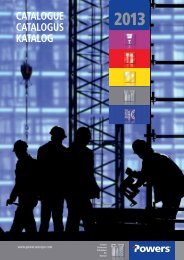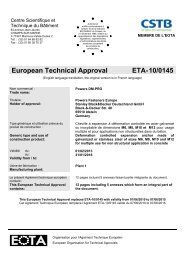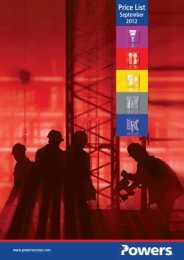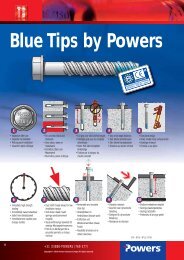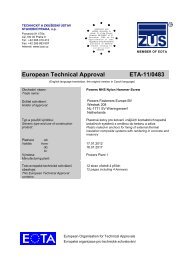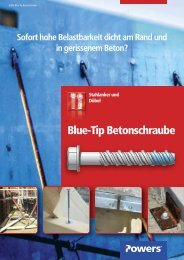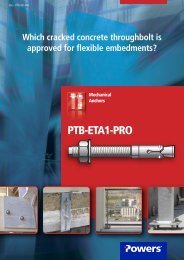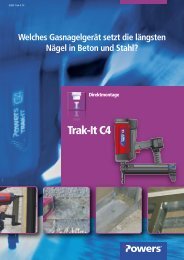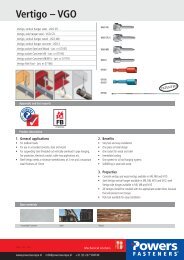European Technical Approval ETA-08/0376 - bei Powers Europe
European Technical Approval ETA-08/0376 - bei Powers Europe
European Technical Approval ETA-08/0376 - bei Powers Europe
Create successful ePaper yourself
Turn your PDF publications into a flip-book with our unique Google optimized e-Paper software.
<strong><strong>Europe</strong>an</strong> technical approval<br />
<strong>ETA</strong>-<strong>08</strong>/<strong>0376</strong><br />
English translation prepared by DIBt<br />
Page 7 of 28 | 8 September 2011<br />
4.2 Design of anchorages<br />
The fitness of the anchor for the intended use is given under the following conditions:<br />
The anchorages are designed in accordance with the EOTA <strong>Technical</strong> Report TR 029 "Design<br />
of bonded anchors" 10 under the responsibility of an engineer experienced in anchorages and<br />
concrete work.<br />
Post-installed reinforcing bars may be used as anchor designed in accordance with the EOTA<br />
<strong>Technical</strong> Report TR 029 only. The basic assumptions for the design according to anchor<br />
theory shall be observed. This includes the consideration of tension and shear loads and the<br />
corresponding failure modes as well as the assumption that the base material (concrete<br />
structural element) remains essentially in the serviceability limit state (either non-cracked or<br />
cracked) when the connection is loaded to failure. Such applications are e.g. concrete overlay<br />
or shear dowel connections or the connections of a wall predominantly loaded by shear and<br />
compression forces with the foundation, where the rebars act as dowels to take up shear<br />
forces. Connections with reinforcing bars in concrete structures designed in accordance with<br />
EN 1992-1-1:2004 (e.g. connection of a wall loaded with tension forces in one layer of the<br />
reinforcement with the foundation) are not covered by this <strong><strong>Europe</strong>an</strong> technical approval.<br />
Verifiable calculation notes and drawings are prepared taking account of the loads to be<br />
anchored.<br />
The position of the anchor is indicated on the design drawings (e.g. position of the anchor<br />
relative to reinforcement or to supports, etc.).<br />
4.3 Installation of anchors<br />
The fitness for use of the anchor can only be assumed if the anchor is installed as follows:<br />
- anchor installation carried out by appropriately qualified personnel and under the supervision<br />
of the person responsible for technical matters of the site,<br />
- anchor installation in accordance with the manufacturer’s specifications and drawings using<br />
the tools indicated in the technical documentation of this <strong><strong>Europe</strong>an</strong> technical approval,<br />
- use of the anchor only as supplied by the manufacturer without exchanging the components,<br />
- commercial standard threaded rods, washers and hexagon nuts may be used if the following<br />
requirements are fulfilled:<br />
• material, dimensions and mechanical properties of the metal parts according to the<br />
specifications given in Annex 3,<br />
• confirmation of material and mechanical properties of the metal parts by inspection<br />
certificate 3.1 according to EN 10204:2004, the documents should be stored,<br />
• marking of the threaded rod with the envisage embedment depth. This may be done by<br />
the manufacturer of the rod or the person on jobsite.<br />
- embedded reinforcing bars shall comply with specifications given in Annex 4,<br />
- checks before placing the anchor to ensure that the strength class of the concrete in which<br />
the anchor is to be placed is in the range given and is not lower than that of the concrete to<br />
which the characteristic loads apply,<br />
- check of concrete <strong>bei</strong>ng well compacted, e.g. without significant voids,<br />
- marking and keeping the effective anchorage depth,<br />
- edge distance and spacing not less than the specified values without minus tolerances,<br />
- positioning of the drill holes without damaging the reinforcement,<br />
10<br />
The Techncial Report TR 029 "Design of bonded anchors" is published in English on EOTA website www.eota.eu.<br />
Z37514.11 8.06.01-109/11




